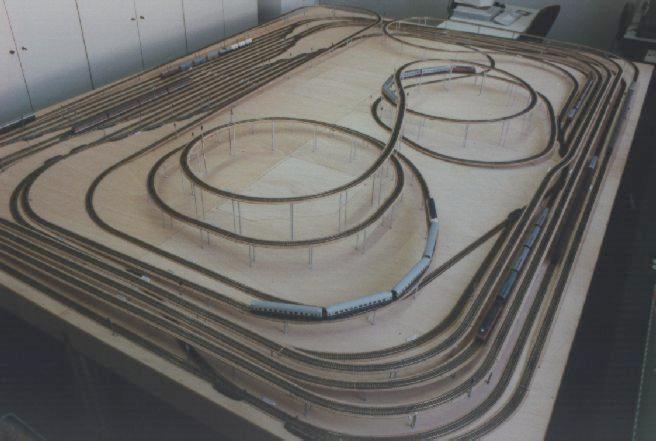![]()
![]() The Model Railway
The Model Railway
![]()
![]() People involved
People involved
![]()
![]() Track System
Track System
![]()
![]() Components
Components
![]()
![]() Petri Net Model
Petri Net Model
![]()
![]() Hardware
Hardware
![]()
![]() Software
Software
![]()
![]() Teaching
Teaching
![]()
![]() Links
Links
![]()
![]() Kicking Horse Pass
Kicking Horse Pass
![]()
![]() Photos
Photos
The Kiel Computer Science Model Railway
In November 1997 the major construction works of the model railway at the chair for computer organization have been finished. Nearly two years after the first ideas spread and after one year of active building, the complete system is now ready to be used. First experiences with a prototype implementation of the control software are made and last bugs removed.
On an area of 4.80m x 3.40m or exactly 16.32 sqm up to 10 trains of H0 scale may be run on a complex track system of approximately 140m length connected by 28 points. The entire system is divided into 47 independently controllable block sections and the traffic is guided by 51 signals. 81 velocity meters distributed all over the system allow to keep track of what's going on on the model railway. All track material and most of the running stock comes from Roco while the light signals are from Busch and the velocity meters are self-made using reed-contacts.

All points, signals, and velocity meters as well as the power supply for the different block sections are connected to a self-designed electronic interface. The electronic interface itself is connected to a Sun work station via the parallel interface. The whole task of controlling the model railway is exclusively done by software running on the work station. Commands by the software, e.g. to switch a signal to red or to turn power off in a specific block section, are transmitted via the parallel interface and executed by the electronic interface. In return, results from velocity meters are processed by the electronic interface and transmitted to the work station where they're analyzed by the control software. The control software may react on the new situation by issuing further commands.
At the chair for computer organization, the model railroad is primarily used in graduate teaching. Lab courses are being held in system's modelling using Petri nets and system's programming. Besides the pure task of controlling trains to behave orderly with respect to signals, etc., the main focus lies on organizational aspects. The model railway is a perfect tool in visiualizing such basic organizational phenomena as concurrency, conflict, deadlock, or fairness. In this sense, the pure control task is naturally extended by the tasks of solving conflicts, preventing deadlocks, and guaranteeing fairness among trains.
Clemens Grelck
generated on: Mon May 31 10:22:24 MET DST 1999